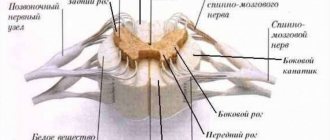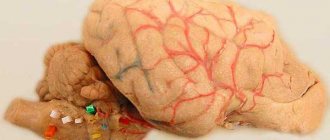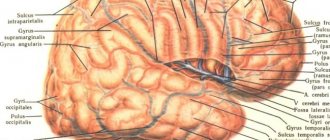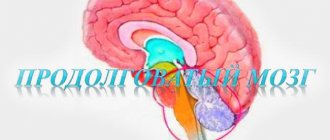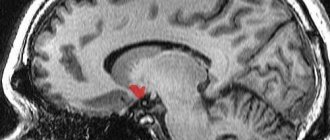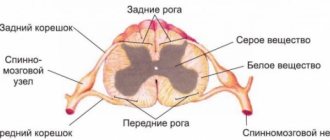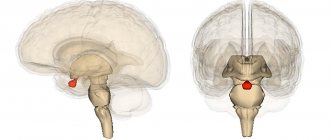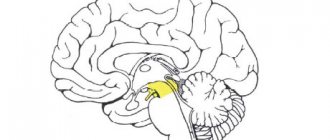The diencephalon is the final section of the brainstem and is completely hidden by the hemispheres. This department is responsible for some behavioral processes; the collector of all the sensitive pathways of the body and the main hormonal regulatory center are located here. Limited:
- In front – anterior commissure (commissure) and terminal plate;
- Posteriorly – posterior commissure, leash commissure and epiphysis;
- Above – the corpus callosum and cerebral hemispheres;
The diencephalon and its anatomy are directly related to the functions performed. Therefore, good blood supply and proximity to key nerve structures are important. The diencephalon consists of the following functional parts:
- The thalamus is an organ in which all sensory data is collected: visual, auditory, olfactory, tactile - and then transmitted to the cortex;
- The metathalamus consists of the geniculate bodies, is the subcortical center of hearing and vision, and is anatomically connected to the thalamus;
- The subthalamus belongs to the group of basal ganglia, it is associated with the performance of fine movements;
- The hypothalamus is the center for the production of hormones that control the activity of the pituitary gland (hypothalamic-pituitary system) and the subcortical center of many behavioral reactions;
- Epithalamus - it is made up of an endocrine gland - the pineal gland, or pineal body.
There is also a third ventricle through which the outflow of cerebrospinal fluid occurs and the optic tracts, nerves and optic chiasm are located.
Thalamus
The thalamus are paired, small, ovoid structures that occupy almost the entire (80%) diencephalon. The main function of this department is the convergence (unification) of all sensitive pathways, their processing and transmission to the cortex. It also prevents unnecessary or low-value signals from entering the brain, which reduces the load on the cortex. The thalamus contains approximately 40 nuclei - clusters of neurons with specialized functions. They are divided into three groups:
- Specific (projection) switch sensory information to the cerebral cortex, modulate a specific signal by which the brain determines where the irritation came from and perceives it. They also process pain information (the highest center of pain sensitivity is located here), so if the thalamus is damaged, it is possible to either reduce the pain threshold or increase it. With the help of specific signals, the thalamus coordinates the actions of the higher lying parts of the central nervous system;
- Nonspecific are associated with the reticular formation, their function is associated with the creation of background excitation. They modulate nonspecific signals that support the excitation of cortical neurons, and also take part in the formation of emotions and facial expressions;
- Associative lobes connect different lobes of the cerebral cortex: temporal, parietal, occipital.
The metathalamus is the medial and lateral geniculate bodies, which constitute the subcortical center of hearing and vision, and are responsible for orientation reflexes. They are connected to the quadrigeminal midbrain (which is an ancient visual center). Their damage threatens complete loss of vision or hearing (while maintaining the integrity of the optic and auditory nerves).
If we talk about the structure of the diencephalon, we also need to highlight the subthalamus, which is the Lewis nucleus. It is strongly connected to the extrapyramidal system and is involved in the system of muscle control and coordination of fine movements. There is also an undefined zone, the functions of which are unknown.
Diencephalon (human anatomy)
The diencephalon is located under the corpus callosum and fornix, fused on the sides with the cerebral hemispheres. It includes the thalamus (visual thalamus), epithalamus (supra-tubercular region), metathalamus (sub-tubercular region) and hypothalamus (sub-tubercular region). The cavity of the diencephalon is the third ventricle.
The thalamus is a paired, ovoid collection of gray matter covered by a layer of white matter. The anterior sections are adjacent to the interventricular foramina, the posterior sections are expanded to the quadrigeminal. The lateral surfaces of the thalamus grow together with the hemispheres and border the caudate nucleus and the internal capsule. The medial surfaces form the walls of the third ventricle, the lower ones continue into the hypothalamus. In the thalamus, there are three main groups of nuclei: anterior, lateral and medial, and there are 40 nuclei in total. In the epithalamus lies the upper appendage of the brain - the pineal gland, or pineal body, suspended on two leashes in the recess between the upper colliculi of the roof plate. The metathalamus is represented by the medial and lateral geniculate bodies, connected by bundles of fibers (handles of the colliculi) with the superior (lateral) and inferior (medial) colliculi of the roof plate. They contain nuclei that are reflex centers of vision and hearing.
The hypothalamus is located ventral to the thalamus and includes the subcutaneous region itself and a number of formations located at the base of the brain. These include: the terminal plate, the optic chiasm, the gray tubercle, the infundibulum with the lower appendage of the brain extending from it - the pituitary gland and the mastoid bodies. In the hypothalamic region there are nuclei (supravisceral, periventricular, etc.) containing large nerve cells capable of secreting a secretion (neurosecretion) that flows along their axons into the posterior lobe of the pituitary gland and then into the blood. In the posterior part of the hypothalamus lie nuclei formed by small nerve cells, which are connected to the anterior lobe of the pituitary gland by a special system of blood vessels.
The third (III) ventricle is located in the midline and is a narrow vertical slit. Its lateral walls are formed by the medial surfaces of the thalamus and the subtubercular region, the anterior - by the columns of the fornix and the anterior commissure, the lower - by the formations of the hypothalamus, and the posterior - by the cerebral peduncles and the supracuberous region. The upper wall - the lid of the third ventricle - is the thinnest and consists of the soft membrane of the brain, lined on the side of the ventricular cavity with an epithelial plate (ependyma). The soft shell has a large number of blood vessels here, forming the choroid plexus. In front, the third ventricle communicates with the lateral ventricles (I - II) through the interventricular foramina, and behind it passes into the cerebral aqueduct.
Physiology of the diencephalon (human anatomy)
The thalamus is a sensitive subcortical nucleus. It is called the “collector of sensitivity”, since afferent pathways from all receptors converge to it, excluding olfactory ones. In the lateral nuclei of the thalamus there is a third neuron of the afferent pathways, the processes of which end in the sensitive zones of the cerebral cortex.
The main functions of the thalamus are integration (unification) of all types of sensitivity, comparison of information received through various communication channels, and assessment of its biological significance. The nuclei of the thalamus are divided according to their function into specific (the ascending afferent pathways end on the neurons of these nuclei), nonspecific (nuclei of the reticular formation) and associative. Through the associative nuclei, the thalamus is connected with all the motor subcortical nuclei: the striatum, the globus pallidus, the hypothalamus - and with the nuclei of the midbrain and medulla oblongata.
The study of the functions of the thalamus is carried out by cutting, irritation and destruction. A cat in which the incision is made above the diencephalon is very different from a cat in which the highest part of the central nervous system is the midbrain. She not only gets up and walks, that is, performs complexly coordinated movements, but also shows all the signs of emotional reactions. A light touch causes an angry reaction: the cat whips its tail, bares its teeth, growls, bites, and extends its claws. In humans, the thalamus plays a significant role in emotional behavior, characterized by peculiar facial expressions, gestures and shifts in the functions of internal organs. During emotional reactions, blood pressure rises, pulse and breathing quicken, and pupils dilate. The facial reaction of a person is innate. If you tickle the nose of a fetus for 5-6 months, you can see a typical grimace of displeasure (P.K. Anokhin). In animals, when the thalamus is irritated, motor and pain reactions occur: squealing, grumbling. The effect can be explained by the fact that impulses from the visual thalamus easily transfer to the associated motor subcortical nuclei.
In the clinic, symptoms of damage to the thalamus are severe headache, sleep disturbances, disturbances in sensitivity (increased or decreased), movements, their accuracy, proportionality, and the occurrence of violent involuntary movements.
The hypothalamus is the highest subcortical center of the autonomic nervous system. In this area there are centers that regulate all vegetative functions, ensuring the constancy of the internal environment of the body, as well as regulating fat, protein, carbohydrate and water-salt metabolism. In the activity of the autonomic nervous system, the hypothalamus plays the same important role as the red nuclei of the midbrain play in the regulation of skeletal-motor functions of the somatic nervous system.
The earliest studies of the function of the hypothalamus belong to Claude Bernard. He discovered that an injection into the diencephalon of a rabbit caused an increase in body temperature of almost 3°C. This classic experiment, which made it possible to discover the thermoregulation center in the hypothalamus, was called heat injection. After the destruction of the hypothalamus, the animal becomes poikilothermic, that is, it loses the ability to maintain a constant body temperature.
Later it was found that almost all organs innervated by the autonomic nervous system can be activated by irritation of the subtubercular region. In other words, all the effects that can be obtained by irritating the sympathetic and parasympathetic nerves are observed when irritating the hypothalamus.
Currently, the method of implanting electrodes is widely used to stimulate various brain structures. Using a special, so-called stereotaxic technique, electrodes are inserted into any given area of the brain through a burr hole in the skull. The electrodes are insulated throughout, only their tip is free. By connecting electrodes in a circuit, you can locally irritate certain areas.
When the anterior parts of the hypothalamus are irritated, parasympathetic effects occur: increased intestinal movements, separation of digestive juices, slowing down heart contractions, etc.; when the posterior sections are irritated, sympathetic effects are observed: increased heart rate, constriction of blood vessels, increased body temperature, etc. Consequently, parasympathetic centers are located in the anterior sections of the hypothalamus, and sympathetic centers in the posterior sections.
Since stimulation with the help of implanted electrodes is carried out on the animal without anesthesia, it is possible to judge the behavior of the animal. In Andersen's experiments on a goat with implanted electrodes, a center was discovered, the irritation of which causes unquenchable thirst - the thirst center. When irritated, the goat could drink up to 10 liters of water. By stimulating other areas, it was possible to force a well-fed animal to eat (hunger center).
The experiments of the Spanish scientist Delgado on a bull became widely known. An electrode was implanted into the bull's fear center. When an angry bull rushed at a bullfighter in the arena, the irritation was turned on and the bull retreated with clearly expressed signs of fear.
American researcher D. Olds proposed modifying the method: allowing the animal itself to make contact (self-irritation method). He believed that the animal would avoid unpleasant stimuli and, on the contrary, would strive to repeat pleasant ones. Experiments have shown that there are structures whose irritation causes an uncontrollable desire to repeat. The rats worked themselves to the point of exhaustion by pressing the lever up to 14,000 times. In addition, structures were discovered whose irritation apparently causes an unpleasant sensation, since the rat avoids pressing the lever a second time and runs away from it. The first center is obviously the center of pleasure, the second is the center of displeasure.
Extremely important for understanding the functions of the hypothalamus was the discovery in this part of the brain of receptors that detect changes in blood temperature (thermoreceptors), osmotic pressure (osmoreceptors) and blood composition (glucoreceptors).
Reflexes arise from receptors “turned into the blood” aimed at maintaining the constancy of the internal environment of the body - homeostasis. “Hungry” blood, irritating glucoreceptors, excites the food center: food reactions arise, aimed at searching and eating food.
One of the common manifestations of hypothalamic disease is a violation of water-salt metabolism, manifested in the release of large amounts of low-density urine. The disease is called diabetes insipidus.
The subcutaneous region is closely related to the activity of the pituitary gland. The hormones vasopressin and oxytocin are produced in large neurons of the supravisual and paraventricular nuclei of the hypothalamus. Hormones travel along axons to the posterior lobe of the pituitary gland, where they accumulate and then enter the blood.
A different relationship between the hypothalamus and the anterior pituitary gland. The vessels surrounding the nuclei of the hypothalamus unite into a system of veins, which reach the anterior lobe of the pituitary gland and here again break up into capillaries. With the blood, releasing factors, or releasing factors, enter the pituitary gland, stimulating the formation of hormones in its anterior lobe.
Reticular formation. In the brain stem and diencephalon, between its specific nuclei, there are clusters of neurons with numerous highly branching processes, forming a dense network. This system of neurons is called a network formation, or reticular formation. Special studies have shown that all the so-called specific pathways that carry certain types of sensitivity from receptors to sensitive areas of the cerebral cortex give off branches in the brain stem that end on the cells of the reticular formation. Streams of impulses from the periphery from extero-, intero- and proprioceptors support constant tonic excitation of the structures of the reticular formation.
Nonspecific pathways begin from the neurons of the reticular formation. They go up to the cerebral cortex and subcortical nuclei and down to the neurons of the spinal cord.
By irritating individual structures of the reticular formation, it was possible to reveal its function as a regulator of the functional state of the spinal cord and brain, as well as the most important regulator of muscle tone. The role of the reticular formation in the activity of the central nervous system is compared to the role of a regulator on a TV: without giving an image, it can change the volume of sound and illumination.
Irritation of the reticular formation does not cause a motor effect, but affects existing activity, inhibiting it or enhancing it. If in a cat a protective reflex is induced by short, rhythmic stimulation of the sensory nerve - flexion of the hind leg, and then against this background the reticular formation is irritated, then depending on the zone of irritation, the effect will be different: the spinal reflexes will either sharply intensify, or become weaker and disappear, i.e. e. will slow down. Inhibition occurs when the posterior parts of the brain stem are irritated, and reflexes are strengthened when the anterior parts are irritated. The corresponding zones of the reticular formation are called inhibitory and activating zones.
The reticular formation has an activating effect on the cerebral cortex, maintaining a state of wakefulness and concentrating attention. If you turn on stimulation of the reticular formation in a sleeping cat with electrodes implanted into the diencephalon, the cat will wake up and open its eyes. On the electroencephalogram, slow waves characteristic of sleep will disappear, and fast waves characteristic of the waking state will appear. The reticular formation has an ascending, generalized (encompassing the entire cortex) activating effect on the cerebral cortex. According to I.P. Pavlov, “the subcortex charges the cortex” (Fig. 115). In turn, the cerebral cortex regulates the activity of the network formation.
Rice. 115. Cat's brain (diagram). Facilitating (5) and inhibitory (4) zones of the reticular formation of the brain stem, as well as connections going to it from the cortex (1), subcortical nuclei (2) and cerebellum (3) (according to Magoon)
content .. 101 102 103 104 105 106 ..
Epithalamus
One of the divisions of the diencephalon is the epithalamus, or pineal gland. It is located above the cerebral aqueduct, has a good blood supply, and is attached by two leashes to the mounds of the roof plate. This is an endocrine gland that produces the following hormones:
Melatonin is a regulator of human circadian rhythms. Failures in its synthesis lead to insomnia, irritability, and drowsiness during the day;
Adrenoglomerulotropin affects the production of aldosterone by the adrenal glands;
Inhibitory hormones inhibit the release of somatotropin and gonadotropin, thereby delaying premature puberty and gigantism in childhood.
Hypothalamus
The structure and functions of the diencephalon provide two main functions: regulatory and endocrine. The hypothalamus itself combines these two functions. It receives multiple signals from different areas of the brain: the thalamus, limbic system, cerebellum and cerebral cortex, and also has its own receptors that allow you to regulate one or another parameter in the body (for example, the volume of circulating blood or salt balance). It contains nuclei responsible for the regulation of autonomic functions, hormonal regulation of the pituitary gland, as well as centers for various basic behavioral reactions. All kernels can be divided into several functional groups:
- Anterior, or chiasmatic, group. These include the anterior hypothalamic, suprachiasmatic, supraoptic, paraventricular nuclei, as well as the ventrolateral and sexomorphic nuclei. The functions of the anterior section are varied: release of antidiuretic hormone and oxytocin, regulation of heat metabolism (the heat transfer center is responsible for vasodilation and sweating), regulation of water balance (with an increase in the amount of salts in the blood, thirst occurs). Also, through the anterior group, a descending parasympathetic effect on the organs is carried out, which also has an adaptive nature: an increase in the production of digestive juices, a slowdown in heart rate, narrowing of the bronchi, lowering blood pressure, and constriction of the pupils. The sleep center is also located in the anterior group of nuclei. In the diencephalon, the function of the anterior group is one of the most important. Damage to these nuclei most often leads to human death.
- Middle, or group of nuclei of the middle tuberosity. These include the arcuate, lateral, dorsomedial and ventromedial nuclei, as well as the tuberosomastoid complex. They are responsible for sexual behavior and energy regulation. The center of hunger and satiety is located here. Its destruction leads to refusal of food or its excessive consumption, which is equally dangerous to human life.
- The posterior, or group of nuclei of the mastoid body, includes the mammillary nuclei. This group of nuclei carries out a descending sympathetic effect on the organs: it increases heart rate, inhibits the secretion of gastric juice, dilates the bronchi and increases blood pressure, dilates the pupils. The center of awakening is located here.
In the diencephalon, the functions of the hypothalamus are reduced to maintaining a constant internal environment - homeostasis.
What is the diencephalon needed for?
The brain consists of several sections, each of which is responsible for certain functions of the body. In fact, scientists have proven that the brain is the most important human organ. Even in conditions of hunger and dehydration, the body, gradually turning off all systems, protects the brain to the last.
Useful to know: Functions and structure of the cerebral pons, its description
The diencephalon is responsible for many functions of the human body. For example, human emotions depend on the functioning of the thalamus, located in the diencephalon. It is he who makes us smile, cry, be sad, suffer and experience happiness.
The human body has 5 sense organs: eyes, tongue, ears, skin, nose. All of them are responsible for the perception of the surrounding world and send signals to the brain. It is the diencephalon that processes these signals and gives commands to other organs. For example, touching a hot object with your hand, the skin sends a signal to the thalamus, which in turn commands the muscles of the hand to move away from the hot object.
The speed of these signals and their processing is instantaneous. Therefore, the diencephalon reacts so quickly to all stimuli and can receive and understand information from the outside at a high speed.
The thalamus is responsible for adequate brain reactions. For example, causing a fear of heights, preventing a person from falling, or understanding the danger posed by fire, sharp objects, water and other risk manifestations that can cause harm. We can say that the thalamus is responsible for the instinct of self-preservation and protects people from risky actions.
Damage or malfunction of the thalamus leads to negative consequences for the human body. The perception of the senses may disappear: hearing, sense of smell may disappear, or an inadequate perception of pain may develop; a person may either not feel pain at all, or, on the contrary, pain can be caused by even the lightest touch to the skin.
Another part of the diencephalon is the hypothalamus. It makes the endocrine system work. It is he who is responsible for the timely production of many hormones, such as oxytocin and vasopressin.
Oxytocin is often called the family hormone. It is responsible for emotions in relationships and is one of the components of the “chemistry of love.” In addition, oxytocin is important for women, it regulates the activity of the uterus, helps during pregnancy and childbirth, and is responsible for lactation.
Vasopressin regulates the volume of fluid in the body, activates the genitourinary system and kidneys. It is this hormone that tells the body to replenish or get rid of fluid.
Useful to know: Midbrain: structure, functions, development
In addition, the hypothalamus is responsible for motivating the human body, causing feelings of hunger or thirst, and regulating sleep and wakefulness. The temperature balance of the body is also influenced by the hypothalamus. It regulates body temperature at a standard level and warns the body of overheating and hypothermia, causing a chain reaction to temperature changes in all organs.
The hypothalamus, among other things, regulates human sexual behavior. Scientists suggest that inappropriate sexual behavior is caused by a disorder of the hypothalamus, which in turn entails mental disorders.
The third section of the diencephalon is the pituitary gland. This small process in the brain determines our appearance, height, weight and other external manifestations.
The pituitary gland is responsible for procreation; it stimulates the production of sperm and follicles, and allows the reproductive system to function properly.
One of the unusual functions of the pituitary gland is the regulation of skin pigmentation. It is responsible for skin color and its changes in different periods. For example, during pregnancy, women may develop pigment spots on their skin, or in the spring, many people may have freckles on their faces; the reason for these skin changes lies in the work of the pituitary gland.
Blood pressure and cardiac muscle tone are also controlled by the pituitary gland. It controls blood clotting and regulates fluid levels in organs and vessels.
to contents ^
Pituitary
The pituitary gland is one of the most important endocrine organs of the body. Its function is to produce tropic hormones, which, acting on target organs (most often the endocrine glands), regulate their activity. The pituitary gland is located in the diencephalon, its structure and functions are anatomically connected to the hypothalamus through the infundibulum, forming the hypothalamic-pituitary system. The pituitary gland itself lies in a bone formation - the sella turcica. Has three parts:
- Adenohypophysis (anterior lobe) - here tropic hormones are synthesized that regulate the activity of the glands: thyroid-stimulating, adrenocorticotropic, gonadotropic, somatotropic, luteotropic (prolactin). A tumor of the pituitary gland can develop from this part (link to one of the articles);
- The middle lobe is where melanocyte-stimulating hormone is synthesized, which affects pigment metabolism.
- Neurohypophysis (posterior lobe) - antidiuretic hormone and oxytocin are stored here, and from here these hormones are released into the blood. It is this part that is connected to the hypothalamus through the infundibulum.
The pituitary gland is called the most important gland of the body; the work of the other endocrine glands depends on its activity. Damage to this organ causes serious diseases: acromegaly, hyperthyroidism, premature puberty.
Embryonic stages of development
At the end of the first month of intrauterine development, the fetus develops three brain vesicles - rhomboid, anterior and middle.
The diencephalon is formed from the anterior bladder, which becomes the wall of the third cerebral ventricle. The anterior vesicle is divided into two parts, which serve as the basis for the development of the diencephalon and telencephalon. The most fleshy are the lateral walls, from which the geniculate bodies and the thalamus and hypothalamus are later formed. The walls of the vesicles consist of three layers - marginal (includes a small number of cells), interstitial and germinal (in the latter, the cells are poorly differentiated and have not formed into full-fledged tissue). The nuclei of brain structures develop from the interstitial layer of the ventral walls. The lateral protrusions of the diencephalon develop into optic cups, which in the later stages of intrauterine development become the optic nerves.
Where the diencephalon vesicle fuses with the adjacent one, the epiphysis and its leashes with triangles are formed from the protrusion of the upper wall. From the dorsal wall, the thinnest of all, the rudiment of the epiphysis buds, and the wall itself fuses with the choroid, forming the roof of the third cerebral ventricle. From a single protrusion of the posterior wall of the diencephalon, the posterior lobe of the pituitary gland and the gray tubercle are formed. Protrusions of the lower wall become prototypes of the gray tubercle, mastoid formations, intermastoid and mastoid recesses.
Third ventricle
The structure of the diencephalon suggests the presence of a cavity through which the outflow of cerebrospinal fluid (CSF) occurs. The third ventricle is a narrow slit-like formation. It is connected to the first and second ventricles through the foramina of Monroy, and to the fourth through the aqueduct. There is a well-developed choroid plexus here. A tumor in this department may result in the diencephalon not being able to perform its functions correctly. The outflow of fluid will be impaired, and the optic tracts and other organs of this part of the brain may be compressed.
Thus, we can distinguish five main functions that the diencephalon has:
- Regulation of the activity of all major endocrine glands;
- Center for adaptation - regulation of temperature, water-salt balance, time of sleep and wakefulness, and other characteristics;
- Neurohumoral regulation - stimulation or inhibition of the activity of the external and internal secretion glands based on information from the environment and the state of the body;
- Center of sexual desire and pleasure;
- Center for the formation of protective reflexes: coughing, lacrimation, sneezing.
Pathologies and their consequences
Considering the variety of functions of the thalamus and connections with different parts of the brain, the influence of its pathologies on the human body is also diverse. It depends on which nuclei are damaged and connections with which parts of the brain are disrupted. Among the frequently encountered symptoms of thalamic dysfunction in the medical literature, the following are described:
- disturbance (confusion) of consciousness and attention;
- various types of amnesia;
- violation of voluntary behavior;
- severe mental pathologies: delirium (dementia), manic disorder, etc.;
- defects in speech behavior, for example, verbal incontinence, excessive agitation, increased volume and tempo of speech, etc.;
- impaired skin sensitivity and a subjective feeling of swelling and heaviness on the side of the body opposite the affected part of the thalamus;
- severe headaches;
- muscle weakness and even paresis (paralysis).
With serious damage to the right or left parts of the thalamus, the so-called thalamic syndrome may occur, which includes a whole complex of pathologies in the side of the body that opposes the affected part:
- various types of paresis;
- violation of vibration sensitivity;
- movement coordination disorder;
- severe pain.
The causes of thalamic dysfunction are most often associated with vascular pathologies, including stroke. But disruptions to this part of the brain can also be caused by trauma and brain tumors. Treatment of thalamic pathologies and their consequences depends on the causes and nature of the lesions. If medications are ineffective, surgical intervention is also used.

